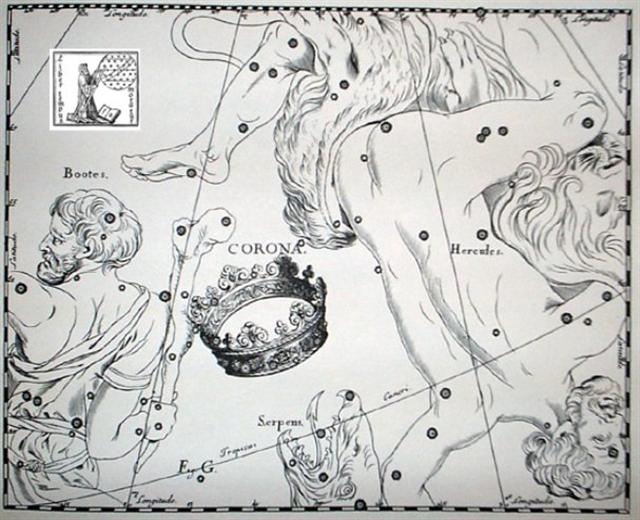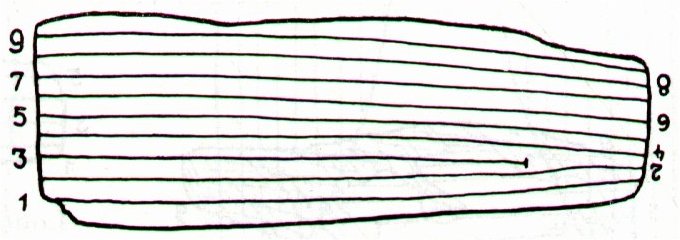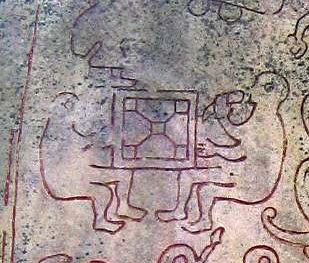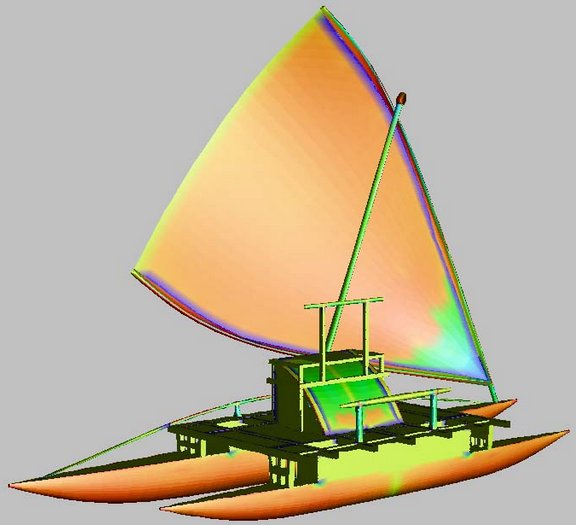6-6. Before Hotu A Matua was able to leave his old
homeland they had to use 6 days for loading his canoe.
... For six days (po ono), mats (moenga)
were taken on board the canoe (i.e., the loading of the
canoe took six days) ... [E:74]
... etahi poō no. o te moenga. i too ai ki runga ki te
miro ...
I guess this 6-day long period might correspond to for instance the difference betwen
November 10 (314) and November 16 (320):
|
N |
ALCYONE |
*56 |
136 |
|
S |
TANIA AUSTRALIS |
*156 |
236 |
|
Febr 4 |
35 |
+ 365 = |
400 |
|
May 15 |
135 |
500 |
|
May 12 (32 + 100) |
13 |
14
(460 + 39) |
15 (500)
→ Febr
4 (*320) |
|
Nov 10 (314
→
π) |
11 →
August 3 (235) |
12
(*236 →
8 * 29½) |
13 (500 - 183) |
 |
 |
 |
 |
|
Ea6-2 |
Ea6-3
(181) |
Ea6-4 |
Ea6-5 |
|
vaha mea |
koia |
kua
vaha |
kiore
→ ki 'ore |
|
Vaha.
Hollow; opening; space between the fingers (vaha
rima); door cracks (vaha papare). Vahavaha,
to fight, to wrangle, to argue with abusive words.
Vanaga. 1. Space, before T; vaha takitua,
perineum. PS Mgv.: vaha, a space, an open place.
Mq.: vaha, separated, not joined. Ta.: vaha,
an opening. Sa.: vasa, space, interval. To.:
vaha, vahaa, id. Fu.: vasa, vāsaà,
id. Niuē: vahā.
2. Muscle, tendon; vahavaha,
id. Vahahora
(vaha 1 -
hora 2),
spring. Vahatoga
(vaha 1 -
toga 1),
autumn. 3. Ta.: vahavaha,
to disdain, to dislike. Ha.: wahawaha,
to hate, to dislike. Churchill.
Mea.
1. Tonsil, gill (of fish). 2. Red (probably
because it is the colour of gills); light red, rose;
also meamea. 3. To grow or to exist in abundance
in a place or around a place: ku-mea-á te maîka,
bananas grow in abundance (in this place); ku-mea-á
te ka, there is plenty of fish (in a stretch of the
coast or the sea); ku-mea-á te tai, the tide is
low and the sea completely calm (good for fishing);
mau mea, abundance. Vanaga. 1. Red;
ata mea, the
dawn. Meamea,
red, ruddy, rubricund, scarlet, vermilion, yellow;
ariga meamea,
florid; kahu meamea
purple; moni meamea,
gold; hanuanua meamea,
rainbow; pua ei meamea,
to make yellow.
Hakameamea, to redden, to make yellow. PS
Ta.: mea,
red. Sa.: memea,
yellowish brown, sere. To.:
memea, drab. Fu.:
mea, blond,
yellowish, red, chestnut. 2. A thing, an object,
elements (mee);
e mea,
circumstance; mea ke,
differently, excepted, save, but;
ra mea, to
belong; mea rakerake,
assault; ko mea,
such a one; a mea nei,
this; a mea ka,
during; a mea,
then; no te mea,
because, since, seeing that;
na te mea,
since; a mea era,
that; ko mea tera,
however, but. Hakamea,
to prepare, to make ready. P Pau., Mgv., Mq., Ta.:
mea, a thing.
3. In order that, for. Mgv.:
mea, because,
on account of, seeing that, since. Mq.:
mea, for. 4.
An individual; tagata
mea, tagata
mee, an individual. Mgv.:
mea, an
individual, such a one. Mq., Ta.:
mea, such a
one. 5. Necessary, urgent;
e mea ka, must
needs be, necessary; e
mea, urgent. 6. Manners, customs. 7. Mgv.:
ako-mea, a
red fish. 8. Ta.: mea,
to do. Mq.: mea,
id. Sa.: mea,
id. Mao.: mea,
id. Churchill.
MARCH 25 (84)
→ 84 + 64 = 148 (May
28) → 132 (May 12) where Nusakan should be at
the Full Moon + 16 (change from waiting to return to
visibility to true heliacal dates).
|
|
INVISIBLY CLOSE TO
THE SUN: |
|
No star listed (52) |
ψ
Persei (53.1)
ACRUX (α
CRUCIS) |
δ
Persei (54.7) |
Al Thurayya-27 (Many Little
Ones) /
Krittikā-3 (Nurses of Kārttikeya)
/
TAU-ONO (Six Stones)
ATIKS =
ο
Persei,
RANA (Frog) =
δ
Eridani
(55.1),
CELAENO (16 Tauri), ELECTRA (17), TAYGETA (19),
ν
Persei (55.3), MAIA (20), ASTEROPE (21), MEROPE (23)
(55.6) |
|
REVERSED NAKSHATRA
→ CLOSE TO THE FULL MOON: |
|
NUSAKAN (Pauper's Bowl) = β Cor. Bor.
(234.0), κ¹ Apodis (234.3), ν Bootis (234.7), ζ Librae
(234.9) |
θ Cor. Borealis (235.3), γ Lupi (235.6),
GEMMA = α
Cor. Bor.,
ZUBEN ELAKRAB = γ Librae, QIN = δ Serpentis, ε Tr.
Austr.
(235.7), μ Cor. Borealis (235.8), υ Librae (235.9)
CAPH
(β Cassiopeiae)
SIRRAH (α Andromedae) |
φ Bootis (236.2), ω Lupi, τ Librae (236.3), ψ¹ Lupi
(236.7), ζ Cor. Borealis (236.9) |
κ
Librae (237.2),
ι
Serpentis (237.4),
ψ²
Lupi,
ρ
Oct.
(237.5), γ Cor. Borealis, η Librae (237.7), COR
SERPENTIS = α Serpentis
(237.9)
*196.0 = *237.4 - *41.4 |
|
... In other words,
the ancient Druidic religion based on the oak-cult will
be swept away by Christianity and the door - the god
Llyr - will languish forgotten in the Castle of
Arianrhod, the Corona Borealis. This helps us to
understand the relationship at Rome of Janus and the
White Goddess Cardea who is ... the Goddess of Hinges
who came to Rome from Alba Longa. She was the hinge on
which the year swung - the ancient Latin, not the
Etruscan year - and her importance as such is recorded
in the Latin adjective cardinalis - as we say in
English 'of cardinal importance - which was also applied
to the four main winds; for winds were considered as
under the sole direction of the Great Goddess until
Classical times ... Notably the Full Moon would ideally be at
the right ascension line of Nusakan
(*234.0) in Corona Borealis in the night
before Sirrah (*0.5) culminated at
21h. My list of star culminations contains
only a selected few of all the stars in my
star list, but we can assume the culmination
(at 21h) of Caph (*0.5) also occurred
in November 11.
 |
|
ALCYONE (*56 → 2
* 28) |
a1 |
32 |
32 |
|
BETELGEUZE (*88) |
a2 |
33 |
65 |
|
NAOS (*121
→
11 * 11) |
a3 |
35 |
100 |
 |
|
TANIA AUSTRALIS
(*156 → 2 * 78) |
a4 |
36 |
78 |
|
PORRIMA (*191) |
a5 |
42 |
|
NUSAKAN (*156 +
*78) |
a6 |
39 |
156 |
|
NASH (*273 → 3 * 91) |
a7 |
39 |
...
August 4 was half a year after February
4.
... In February 4 (400) the Full Moon would
ideally reach the right ascension line connecting up to
Dramasa, the south pole star: ...
Far away, the Mangaians of old (Austral Islands, Polynesia), who
kept the precessional clock running instead of switching over to
'signs', claim that only at the evening of the solstitial days
can spirits enter heaven, the inhabitants of the northern parts
of the island at one solstice, the dwellers in the south at the
other ...
... *320 (Dramasa) - *236 (November 12) = *54 (May 14) ...
...
In August 4 (216) the Sun rose together with
Talitha Australis
(κ at the vertically oriented
and uplifted right front paw of Ursa Major) and this was 20
days before the Southern Gazelle:
Tania Australis
(μ at the flat uplifted
left back paw). Kappa comes before my ...
Also the figure depicted as glyph number 185 was looking back:
|
May 16 (136) |
17 |
18 |
19
→
Febr 8 (39, *324) |
20 (40 + 100) |
|
... On February 9
the Chorti Ah K'in, 'diviners', begin the
agricultural year. Both the 260-day cycle and the
solar year are used in setting dates for religious
and agricultural ceremonies, especially when those
rituals fall at the same time in both calendars. The
ceremony begins when the diviners go to a sacred
spring where they choose five stones with the proper
shape and color. These stones will mark the five
positions of the sacred cosmogram created by the
ritual. When the stones are brought back to the
ceremonial house, two diviners start the ritual by
placing the stones on a table in a careful pattern
that reproduces the schematic of the universe. At
the same time, helpers under the table replace last
year's diagram with the new one. They believe that
by placing the cosmic diagram under the base of God
at the center of the world they demonstrate that God
dominates the universe. The priests place the stones
in a very particular order. First the stone that
corresponds to the sun in the eastern, sunrise
position of summer solstice is set down; then the
stone corresponding to the western, sunset position
of the same solstice. This is followed by stones
representing the western, sunset position of the
winter solstice, then its eastern, sunrise position.
Together these four stones form a square. They sit
at the four corners of the square just as we saw in
the Creation story from the Classic period and in
the Popol Vuh. Finally, the center stone is placed
to form the ancient five-point sign modern
researchers called the quincunx ...
 |
|
Nov 14 |
15 |
16 (320) |
17 |
18 |
 |
 |
 |
 |
 |
|
Ea6-6 (184) |
Ea6-7 |
Ea6-8 |
Ea6-9 |
Ea6-10 (188) |
|
kua tuu ko raua |
kiore
→ ki 'ore |
oho - te henua |
manu kara vera |
te ahi |
|
Kará. Wing of bird. Karaga,
uproar, row: he-tagi te karaga. Karatu'u,
to remain upright (said of a spinning top).
Karava, low cave; hiding place under rocks in
the sea (where lobsters hide). Tagata kava -
tagata kakara i te kava, man with smelly
armpits.Vanaga. Wing. Karatia, grace.
Karava: 1. Cave. 2. To strain to hit a mark.
Karavarava, manava karavarava, colic.
Churchill. Pau.: Kara, flint. Mgv.: kara,
a heavy stone. Ta.: ará, a black flint. Ma.:
kara, basalt. Karaea, karamea
clay. Ta.: araea, id. Mq.: kaaea, red
ochre. Ma.: karamea, id. Karaga-puruga,
mother-in-law. Ta.: purua, parent-in-law.
Karaini, bait, decoy, allurement. Ta.: arainu,
bait, lure. Karapoga, throat, gullet.
Churchill. Mgv.: Karaga, a cry. Sa.:
'alaga, id. Ma.: karanga, id. Karakara,
to smell slightly a pleasant odor. Ta.: aara,
good odor. Mq.: kakaa, to exhale a pleasant
odor. Sa.: 'alala, to smell of hot meat. Ma.:
kakara, savory. Karako, a bird. Mq.:
kaako, id. Karapihi, suckers of the
octopus. Mq.: karapihi, kaapihi, id.
Karava, large veins which appear under
strain. Sa.: 'alava, veins, fibers.
Churchill. Mq.: Karakara, a bird. Ha.:
alaala, id. Churchill.
Vera mahana, hot. Moa
gao verapaka, chicken with bald neck.
Vera paka, scorching hot. Tuavera,
the last breadfruit spoiled by the wind. Ta.:
tuavera, burnt by the sun. Churchill.
Huero veravera,
burning ray.
|
|
INVISIBLY
CLOSE TO THE SUN: |
|
Hairy Head-18 (Cockerel)
/
Temennu-3 (Foundation Stone)
ALCYONE
(56.1),
PLEIONE (28 Tauri), ATLAS (27 Tauri)
(56.3) |
MENKHIB (Next to the Pleiades =
ζ
Persei
(57.6)
PORRIMA (γ Virginis) |
ZAURAK (Boat) = γ Eridani
(58.9) |
λ Tauri (59.3), ν Tauri (59.9) |
4h (60.9)
JĪSHUĬ = λ Persei (60.7)
COR CAROLI (α Canum Ven.) |
|
REVERSED
NAKSHATRA → CLOSE TO THE FULL MOON: |
|
π
Cor. Borealis,
UNUK ELHAIA (Necks of the Serpents) =
λ
Serpentis
(238.1),
CHOW =
β
Serpentis
(238.6) |
κ
Serpentis (239.3),
δ
Cor. Borealis,
TIĀNRŪ =
μ
Serpentis
(239.5),
χ
Lupi, (239.6),
ω
Serpentis (239.7),
BA (= Pa) =
ε
Serpentis,
χ
Herculis (239.8).
κ
Cor.
Borealis, ρ Serpentis (239.9) |
λ
Librae (240.0),
β
Tr. Austr. (240.3),
κ
Tr. Austr. (240.4),
ρ
Scorpii (240.8)
*199.0 = *240.4 - *41.4 |
Iklīl al Jabhah-15 (Crown of
the Forehead) /
Anuradha-17 (Following Rādhā)
/
Room-4 (Hare)
ξ
Lupi,
λ Cor. Bor.(241.1),
ZHENG =
γ
Serpentis,
θ
Librae (241.2),
VRISCHIKA =
π
Scorpii
(241.3),
ε
Cor.
Borealis (241.5),
DSCHUBBA
(Front of Forehead) = δ Scorpii
(241.7), η Lupi (241.9) |
υ
Herculis (242.3),
ρ
Cor. Borealis (242.4),
ι
Cor. Borealis (242.5),
θ
Draconis (242.6),
ξ
Scorpii (242.7)
SCHEDIR
(Breast) α Cassiopeiae
*201.0 = *242.4 - *41.4 |
 |
But we need not spend more time and effort in order to find out
what stars ideally would have been at the Full Moon when the
royal canoe sailed away, for we have the statement in
Manuscripte E:
... Hotu's canoe [te miro. o Hotu] sailed [he oho]
from Maori to Te Pito O Te Kainga. It sailed on the second
day of September (hora nui) ... [E:74]

And by now it ought to have become clear that there were basic
calendar structures which ruled everything.
For instance, there were 6 days at the beginning of both
side a and
side b of the C tablet although the stars were
not the same.
Day 398 (→ Cb1-6) - 210
(→ 420 / 2) = 188
(Ea6-10) → November 18 was therefore possible to connect not only
to the
culmination of the Breast of Cassiopeia but also
to be reused in other circumstances.
On Hawaii November 18 (322,
*242 = *236 + *6 → August 4 +
106) was noted
as a special day:
... The correspondence between the winter solstice and the
kali'i rite of the Makahiki is arrived at as
follows: ideally, the second ceremony of 'breaking the
coconut', when the priests assemble at the temple to spot
the rising of the Pleiades, coincides with the full moon (Hua
tapu) of the twelfth lunar month (Welehu). In
the latter eighteenth century, the Pleiades appear at sunset
on 18 November. Ten days later (28 November), the Lono
effigy sets off on its circuit, which lasts twenty-three
days, thus bringing the god back for the climactic battle
with the king on 21 December, the solstice (= Hawaiian 16
Makali'i). The correspondence is 'ideal' and only rarely
achieved, since it depends on the coincidence of the full
moon and the crepuscular rising of the Pleiades ...
Probably
it was no coincidence that side b of the G tablet was designed
to carry 242 glyphs.
We
should now move on from November 18 to November 28 (→ 300 + 32), which distance
according to the E text evidently should first
cover what could be 6 days 'for loading the canoe'. 354 (→ 12 *
29½) + 6 =
360 (→ 360º for a full circle).
|
May 21 |
22 (142) |
23 |
24 |
25
(145, *65) |
26 |
|
Nov 19 |
20 (324. *244) |
21 |
22 |
23 |
24 |
 |
 |
 |
 |
 |
 |
|
Ea6-11 |
Ea6-12 |
Ea6-13 |
Ea6-14 |
Ea6-15 |
Ea6-16 |
|
koia - hoko henua - hakatupu |
mauga - ko koe - henua |
tagata - he taau - kiore |
hokohuki - kiore |
|
Tupu.
1. Shoot, sprout, bud; to sprout, to bud. 2.
Pregnant: vî'e tupu (o te poki); to be conceived
(of fetus in its mother's womb): he-tupu te poki i
roto i te kopú o toona matu'a. Vanaga. To grow, to
sprout, to germinate, to come forth, to conceive,
pregnant, germ; mea tupu, plant; tupu ke avai,
of rapid growth; tupu horahorau, precocious;
hakatupu, to produce, to stimulate growth, to
excite. P Pau.: fakatupu, to raise up, to create.
Mgv.: tupu, to grow, to conceive, to be pregnant.
Mq.: tupu, to grow, to sprout, to conceive. Ta.:
tupu, to grow, to sprout. Churchill. Mgv.:
Tupu, the best or worst, used of men or of bad
qualities. Sa.: tupu, king. Ma.: tupu,
social position, dignity. Churchill. |
|
REVERSED NAKSHATRA
→ CLOSE TO THE FULL MOON: |
|
16h (243.5)
ACRAB (Scorpion) =
β
Scorpii,
JABHAT AL ACRAB (Forehead of the Scorpion) =
ω
Scorpii
(243.3),
θ
Lupi,
RUTILICUS =
β
Herculis
(243.5),
MARFIK (Elbow) =
κ
Herculis
(243.7),
φ
Herculis (243.8) |
ψ
Scorpii (244.6),
LESATH (Sting) =
ν
Scorpii
(244.8) |
χ
Scorpii (245.1),
YED PRIOR (Hand in Front) =
δ
Ophiuchi,
δ
Tr.
Austr. (245.5) |
YED POSTERIOR (Hand Behind) =
ε
Ophiuchi,
RUKBALGETHI SHEMALI (Northern Knee of the Giant) =
τ
Herculis
(246.6).
δ
Apodis (246.7),
ο
Scorpii (246.8) |
Heart-5 (Fox)
σ
Scorpii
(247.0),
HEJIAN =
γ
Herculis
(247.2),
ψ
Ophiuchi (247.7) |
ρ
Ophiuchi (248.1),
KAJAM (Club) =
ω
Herculis
(248.3),
χ
Ophiuchi (248.5),
SHE LOW (Market Tower) =
υ
Ophiuchi,
Tr.
Austr. (248.7), ζ Tr. Austr. (248.8) |
 |
|
May 27 |
28 (148, *68) |
29 |
30 |
|
Nov 25 (329, *249) |
26 |
27 |
28 |
 |
 |
 |
 |
|
Ea6-17 |
Ea6-18 |
Ea6-19 |
Ea6-20 (198) |
|
tagata mau - moa |
te honu paka |
moa |
kua kau |
|
Paka.
1. Dry; to become dry (of things);
pakapaka, to dry out. Te paka is also the
name of the moss-covered areas, between the small lakes
of volcano Rano Kau, through which one can pass
without getting one's feet wet. 2. To go, to depart;
he-paka-mai, to come; he-oho, he-paka, they
go away. 3. To become calm (of the sea): ku-paka-á te
tai. Pakahera, skull, shell, cranium;
pakahera puoko tagata, human skull; pakahera
pikea, shell of crab or crayfish. Gutu pakapaka,
scabbed lips. Hau paka, fibres of the hauhau
tree, which were first soaked in water, then dried to
produce a strong thread. Moa gao verapaka,
chicken with bald neck. Ariki Paka, certain
collateral descendents of Hotu Matu'a, who
exercised religious functions. Vanaga. 1. Crust, scab,
scurf; paka rerere, cancer; pakapaka,
crust, scabby. 2. Calm, still. 3. Intensive; vera
paka, scorching hot; marego paka, bald;
nunu paka, thin. 4. To arrive, to come. 5. To be
eager. 6. To absorb. 7. Shin T. Pakahera,
calabash, shell, jug. Pakahia, to clot, curdle,
coagulate. Pakapaka, dry, arid, scorching hot,
cooked too much, a desert, to fade away, to roast, a
cake, active; toto pakapaka, coagulated blood;
hakapakapaka, to dry, to broil, to toast.
Pakahera pikea, shell of crab or crayfish.
Churchill. Kau. 1. To move one's feet
(walking or swimming); ana oho koe, ana kau i te
va'e, ka rava a me'e mo kai, if you go and move your
feet, you'll get something to eat; kakau (or also
kaukau), move yourself swimming. 2. To spread (of
plants): ku-kau-áte kumara, the sweet potatoes
have spread, have grown a lot. 3. To swarm, to mill
around (of people): ku-kau-á te gagata i mu'a i tou
hare, there's a crowd of people milling about in
front of your house. 4. To flood (of water after the
rain): ku-kau-á te vai haho, the water has
flooded out (of a container such as a taheta). 5.
To increase, to multiply: ku-kau-á te moa, the
chickens have multiplied. 6. Wide, large: Rano Kau, 'Wide
Crater' (name of the volcano in the southwest corner of
the island). 7. Expression of admiration: kau-ké-ké!
how big! hare kau-kéké! what a big house!
tagata hakari kau-kéké! what a stout man! Vanaga. To
bathe, to swim; hakakau, to make to swim. P Pau.,
Mgv., Mq.: kau, to swim. Ta.: áu, id.
Kauhaga, swimming. Churchill. The
stem kau does not appear independently in any
language of Polynesian proper. For tree and for timber
we have the composite lakau
in various stages of transformation. But kau will
also be found as an initial
component of various tree names. It is in Viti that we
first find it in free existence. In Melanesia this form
is rare. It occurs as kau in Efaté, Sesake, Epi,
Nguna, and perhaps may be preserved in Aneityum; as
gau in Marina; as au in Motu and somewhere in
the Solomon islands. The triplicity of the Efaté forms [kasu,
kas, kau] suggests a possible transition.
Kasu and kas are easy to be correlated,
kasu and kau less easy. They might be linked
by the assumption of a parent form kahu, from
which each might derive. This would appear in modern
Samoan as kau; but I have found it the rule that
even the mildest aspirate in Proto-Samoan becoming
extinct in modern Samoan is yet retained as aspiration
in Nuclear Polynesia and as th in Viti, none of
which mutations is found on this record. Churchill 2 |
|
REVERSED NAKSHATRA →
CLOSE TO THE FULL MOON: |
|
Al Kalb-16 (The Heart)
/
Jyeshtha-18 (Eldest) /
ANA-MUA-1 (Entrance pillar)
ANTARES = α Scorpii
(249.1),
MARFIK (Elbow) = λ Ophiuchi,
φ Ophiuchi (249.5), ω Ophiuchi (249.8) |
γ Apodis (250.1), σ Herculis (250.3), θ Tr. Austr.
(250.6), τ Scorpii (250.7) |
HAN = ζ Ophiuchi
(251.0) |
ζ Herculis, η Tr. Austr. (252.1), η Herculis, β Apodis
(252.5) |
And 360 + 4 = 364 (→ 13 * 28 → 26
fortnights).

|

















